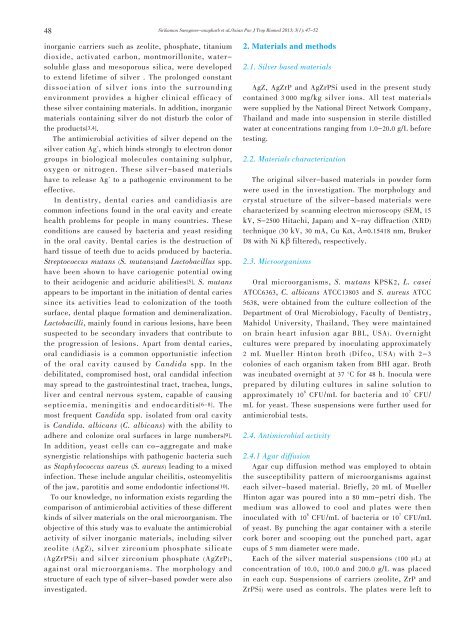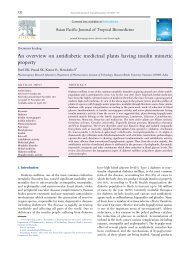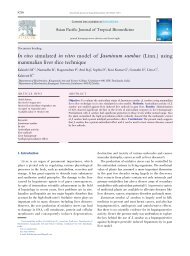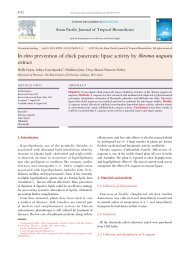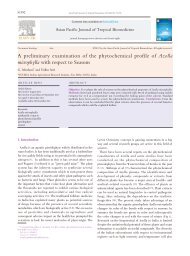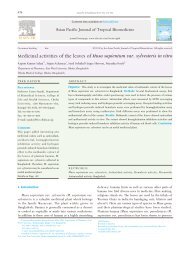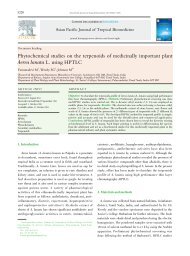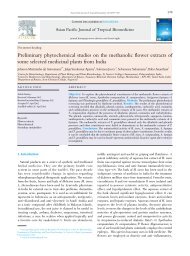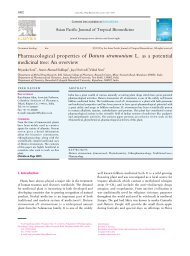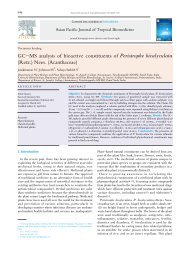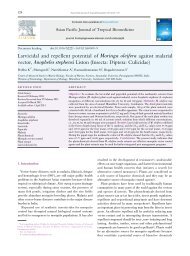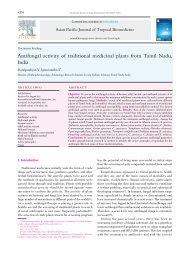Antimicrobial effects of silver zeolite, silver zirconium phosphate ...
Antimicrobial effects of silver zeolite, silver zirconium phosphate ...
Antimicrobial effects of silver zeolite, silver zirconium phosphate ...
You also want an ePaper? Increase the reach of your titles
YUMPU automatically turns print PDFs into web optimized ePapers that Google loves.
48<br />
Sirikamon Saengmee-anupharb et al./Asian Pac J Trop Biomed 2013; 3(1): 47-52<br />
inorganic carriers such as <strong>zeolite</strong>, <strong>phosphate</strong>, titanium<br />
dioxide, activated carbon, montmorillonite, watersoluble<br />
glass and mesoporous silica, were developed<br />
to extend lifetime <strong>of</strong> <strong>silver</strong> . The prolonged constant<br />
dissociation <strong>of</strong> <strong>silver</strong> ions into the surrounding<br />
environment provides a higher clinical efficacy <strong>of</strong><br />
these <strong>silver</strong> containing materials. In addition, inorganic<br />
materials containing <strong>silver</strong> do not disturb the color <strong>of</strong><br />
the products[3,4].<br />
The antimicrobial activities <strong>of</strong> <strong>silver</strong> depend on the<br />
<strong>silver</strong> cation Ag + , which binds strongly to electron donor<br />
groups in biological molecules containing sulphur,<br />
oxygen or nitrogen. These <strong>silver</strong>-based materials<br />
have to release Ag +<br />
to a pathogenic environment to be<br />
effective.<br />
In dentistry, dental caries and candidiasis are<br />
common infections found in the oral cavity and create<br />
health problems for people in many countries. These<br />
conditions are caused by bacteria and yeast residing<br />
in the oral cavity. Dental caries is the destruction <strong>of</strong><br />
hard tissue <strong>of</strong> teeth due to acids produced by bacteria.<br />
Streptococcus mutans (S. mutans)and Lactobacillus spp.<br />
have been shown to have cariogenic potential owing<br />
to their acidogenic and aciduric abilities[5]. S. mutans<br />
appears to be important in the initiation <strong>of</strong> dental caries<br />
since its activities lead to colonization <strong>of</strong> the tooth<br />
surface, dental plaque formation and demineralization.<br />
Lactobacilli, mainly found in carious lesions, have been<br />
suspected to be secondary invaders that contribute to<br />
the progression <strong>of</strong> lesions. Apart from dental caries,<br />
oral candidiasis is a common opportunistic infection<br />
<strong>of</strong> the oral cavity caused by Candida spp. In the<br />
debilitated, compromised host, oral candidal infection<br />
may spread to the gastrointestinal tract, trachea, lungs,<br />
liver and central nervous system, capable <strong>of</strong> causing<br />
septicemia, meningitis and endocarditis[6-8]. The<br />
most frequent Candida spp. isolated from oral cavity<br />
is Candida. albicans (C. albicans) with the ability to<br />
adhere and colonize oral surfaces in large numbers[9].<br />
In addition, yeast cells can co-aggregate and make<br />
synergistic relationships with pathogenic bacteria such<br />
as Staphylococcus aureus (S. aureus) leading to a mixed<br />
infection. These include angular cheilitis, osteomyelitis<br />
<strong>of</strong> the jaw, parotitis and some endodontic infections[10].<br />
To our knowledge, no information exists regarding the<br />
comparison <strong>of</strong> antimicrobial activities <strong>of</strong> these different<br />
kinds <strong>of</strong> <strong>silver</strong> materials on the oral microorganism. The<br />
objective <strong>of</strong> this study was to evaluate the antimicrobial<br />
activity <strong>of</strong> <strong>silver</strong> inorganic materials, including <strong>silver</strong><br />
<strong>zeolite</strong> (AgZ), <strong>silver</strong> <strong>zirconium</strong> <strong>phosphate</strong> silicate<br />
(AgZrPSi) and <strong>silver</strong> <strong>zirconium</strong> <strong>phosphate</strong> (AgZrP),<br />
against oral microorganisms. The morphology and<br />
structure <strong>of</strong> each type <strong>of</strong> <strong>silver</strong>-based powder were also<br />
investigated.<br />
2. Materials and methods<br />
2.1. Silver based materials<br />
AgZ, AgZrP and AgZrPSi used in the present study<br />
contained 3 000 mg/kg <strong>silver</strong> ions. All test materials<br />
were supplied by the National Direct Network Company,<br />
Thailand and made into suspension in sterile distilled<br />
water at concentrations ranging from 1.0-20.0 g/L before<br />
testing.<br />
2.2. Materials characterization<br />
The original <strong>silver</strong>-based materials in powder form<br />
were used in the investigation. The morphology and<br />
crystal structure <strong>of</strong> the <strong>silver</strong>-based materials were<br />
characterized by scanning electron microscopy (SEM, 15<br />
kV, S-2500 Hitachi, Japan) and X-ray diffraction (XRD)<br />
technique (30 kV, 30 mA, Cu Kα, λ=0.15418 nm, Bruker<br />
D8 with Ni Kβ filtered), respectively.<br />
2.3. Microorganisms<br />
Oral microorganisms, S. mutans KPSK2, L. casei<br />
ATCC6363, C. albicans ATCC13803 and S. aureus ATCC<br />
5638, were obtained from the culture collection <strong>of</strong> the<br />
Department <strong>of</strong> Oral Microbiology, Faculty <strong>of</strong> Dentistry,<br />
Mahidol University, Thailand, They were maintained<br />
on brain heart infusion agar BBL, USA). Overnight<br />
cultures were prepared by inoculating approximately<br />
2 mL Mueller Hinton broth (Difco, USA) with 2-3<br />
colonies <strong>of</strong> each organism taken from BHI agar. Broth<br />
was incubated overnight at 37 °C for 48 h. Inocula were<br />
prepared by diluting cultures in saline solution to<br />
approximately 10 8 CFU/mL for bacteria and 10 7 CFU/<br />
mL for yeast. These suspensions were further used for<br />
antimicrobial tests.<br />
2.4. <strong>Antimicrobial</strong> activity<br />
2.4.1 Agar diffusion<br />
Agar cup diffusion method was employed to obtain<br />
the susceptibility pattern <strong>of</strong> microorganisms against<br />
each <strong>silver</strong>-based material. Briefly, 20 mL <strong>of</strong> Mueller<br />
Hinton agar was poured into a 80 mm-petri dish. The<br />
medium was allowed to cool and plates were then<br />
inoculated with 10 8 CFU/mL <strong>of</strong> bacteria or 10 7 CFU/mL<br />
<strong>of</strong> yeast. By punching the agar container with a sterile<br />
cork borer and scooping out the punched part, agar<br />
cups <strong>of</strong> 5 mm diameter were made.<br />
Each <strong>of</strong> the <strong>silver</strong> material suspensions (100 µL) at<br />
concentration <strong>of</strong> 10.0, 100.0 and 200.0 g/L was placed<br />
in each cup. Suspensions <strong>of</strong> carriers (<strong>zeolite</strong>, ZrP and<br />
ZrPSi) were used as controls. The plates were left to


